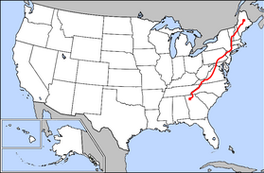
Back Appalachiese-staproete Afrikaans درب الأبالاش Arabic Пътека на апалачите Bulgarian Sender dels Apalatxes Catalan Appalachian National Scenic Trail CEB Appalačská stezka Czech Appalachian Trail Danish Appalachian Trail German Sendero de los Apalaches Spanish Apalatxeetako bidezidorra Basque
| Appalachian Trail | |
|---|---|
 Appalachian Trail logo | |
| Length | 2,197.4 miles (3,536.4 km) in 2024[1] |
| Location | Appalachian Mountains |
| Designation | National Scenic Trail |
| Trailheads | Springer Mountain, Georgia Mount Katahdin, Maine |
| Use | Hiking, backpacking |
| Highest point | Clingmans Dome, 6,643 ft (2,025 m) |
| Lowest point | Bear Mountain State Park, 124 ft (38 m) |
| Difficulty | Easy to strenuous |
| Season | Early spring to autumn for thru-hikers; year-round for other users |
| Website | Appalachian National Scenic Trail |
| Trail map | |
 | |
The Appalachian Trail, also called the A.T., is a hiking trail in the Eastern United States, extending almost 2,200 miles (3,540 km) between Springer Mountain in Georgia and Mount Katahdin in Maine, and passing through 14 states.[2] The Appalachian Trail Conservancy claims the Appalachian Trail to be the longest hiking-only trail in the world.[3] More than three million people hike segments of the trail each year.[4]
The trail was first proposed in 1921 and completed in 1937. Improvements and changes have continued since then. It became the Appalachian National Scenic Trail under the National Trails System Act of 1968.
The trail is maintained by 31 trail clubs and multiple partnerships,[5] and managed by the National Park Service, United States Forest Service, and the nonprofit Appalachian Trail Conservancy.[6][7] Most of the trail is in forest or wild lands, although some portions traverse towns, roads and farms. From south to north it passes through the states of Georgia, North Carolina, Tennessee, Virginia, West Virginia, Maryland, Pennsylvania, New Jersey, New York, Connecticut, Massachusetts, Vermont, New Hampshire, and Maine.
Thru-hikers walk the entire trail in a single season. The number of thru-hikes per year has increased steadily since 2010,[4] with 715 northbound and 133 southbound thru-hikes reported for 2017.[8] The Appalachian Trail Conservancy estimates there are over 3,000 attempts to traverse the entire trail each year, about 25% of which succeed.[9] Many books, documentaries, and websites are dedicated to the pursuit. Some hike from one end to the other, then turn around and thru-hike the trail the other way, known as a "yo-yo".[10]
Affiliated trail sections extend from either end from the north as the International Appalachian Trail into Canada and beyond, and from the south as the Eastern Continental Trail into the Southeastern states of Alabama and Florida.
The Appalachian Trail, the Continental Divide Trail, and the Pacific Crest Trail informally constitute the Triple Crown of Hiking in the United States.[11][12]
- ^ "Appalachian Trail Becomes One Mile Shorter in 2024 | Appalachian Trail Conservancy". Appalachian Trail Conservancy |. December 15, 2023. Retrieved January 6, 2024.
- ^ Gailey, Chris (2006). "Appalachian Trail FAQs" Archived May 5, 2008, at the Wayback Machine Outdoors.org (accessed September 14, 2006)
- ^ "About Us | Appalachian Trail Conservancy". Appalachian Trail Conservancy |. January 3, 2020. Retrieved May 16, 2022.
- ^ a b "Media Room | Appalachian Trail Conservancy". Appalachian Trail Conservancy |. February 13, 2020. Retrieved May 19, 2022.
- ^ "Clubs & Partners | Appalachian Trail Conservancy". Appalachian Trail Conservancy |. January 29, 2020. Retrieved May 16, 2022.
- ^ (January 1985), "A Fork in the Trail". Audubon. 87 (1):140–141
- ^ Cite error: The named reference
Applebomewas invoked but never defined (see the help page). - ^ "Appalachian Trail Conservancy - 2000 Milers". Archived from the original on July 30, 2016. Retrieved July 2, 2016.
- ^ Murphy, Jen (July 18, 2022). "Go take a hike - for a few months". The Wall Street Journal. Dow Jones.
- ^ "Ultralight Maine Hiker "Yo-Yos" the AT | Appalachian Mountain Club – Maine Chapter". November 20, 2008. Archived from the original on June 19, 2018. Retrieved June 18, 2018.
- ^ "Nimblewill Nomad Receives Triple Crown Award". International Appalachian Trail. Archived from the original on January 7, 2009. Retrieved November 27, 2008.
- ^ Adams, Glenn (October 27, 2001). "Hiker Achieves 'Triple Crown'". The Washington Post. Archived from the original on June 1, 2010. Retrieved November 27, 2008.
© MMXXIII Rich X Search. We shall prevail. All rights reserved. Rich X Search